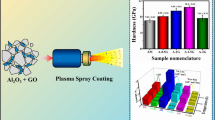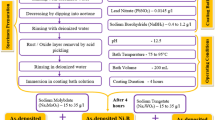The mechanical and tribotechnical properties of detonation-sprayed coatings produced from (Ti, Cr)B2–NiAlCr composites were studied. The influence of various preliminary substrate treatment methods and refractory-to-metal ratio in the spray material on the coating–substrate adhesion strength, σad, was analyzed. Spraying a sublayer had no significant effect on the coating adhesion strength. The adhesion strength σad increased by 25–30% with the metal content changing from 25 to 75%, while σad = 120–145 MPa even at 25% NiAlCr. The hardness of the coatings changed within rather narrow limits (HV0.2 = 7–12 GPa), but the refractory-to-metal ratio varied over a wide range. The coatings containing a minimum amount of the metal component (25%) were predicted to have higher hardness, HV0.2 = 10–12 GPa, though it was almost half the hardness of the sintered compact material. At equal contents of the refractory and metal components, HV0.2 = 9–10 GPa; for the material containing 75% of the metal component, HV0.2 = 7–8 GPa. The tribotechnical properties of the coatings were studied in dry sliding friction conditions with ball-ondisk tests. At the initial friction stage, high pressures appeared in the contact zone (P ≥ 500 MPa). Therefore, in addition to high hardness, the coatings should have high strength. At 50–75% (Ti, Cr)B2, besides abrasion processes, brittle fracture and spalling of the coatings occurred. The best characteristics were shown by the coating produced from the material containing 25% (Ti, Cr)B2. Since the (Ti, Cr)B2 particles are fine, wetted well by the NiAlCr alloy, and uniformly distributed over the starting material and associated coating, even their relatively low content (25%) promotes high abrasion resistance and adhesion.









Similar content being viewed by others
References
V.P. Konoval, O.P. Umanskyi, O.A. Bondarenko, K.M. Haltsov, A. Leitans, I. Boiko, and I.S. Martseniuk, “Detonation-sprayed coatings of (Ti, Cr)B2–NiAlCr composite materials. I. Deposition technique and composition and microstructure of coatings,” Powder Metall. Met. Ceram., 59, No. 5–6, 308–317 (2020).
S.S. Bartenev, Yu.P. Fedko, and A.I. Grigorov, Detonation Coatings in Mechanical Engineering [in Russian], Mashinostroenie, Leningrad (1982), p. 215.
Yinglong Wang, “Friction and wear performances of detonation gun and plasma sprayed ceramic and cermet hard coatings under dry friction,” Wear, 161, No. 1–2, 69–78 (1993).
G. Sundararajan, D. Sen, and G. Sivakumar, “The tribological behavior of detonation sprayed coatings: the importance of coating process parameters,” Wear, 258, No. 1–4, 377–391 (2005).
A.I. Zverrev, E.A. Astakhov, and S.Yu. Sharivker, Detonation Spraying of Coatings [in Russian], Sudostroenie, Leningrad (1979), p. 232.
M.Kh. Shorshorov and Yu.A. Kharlamov, Physicochemical Fundamentals of Detonation Spraying [in Russian], Nauka, Moscow (1978), p. 224.
A.P. Umanskii, V.P. Konoval, A.D. Panasyuk, I.A. Podchernyaeva, V.V. Malyshkin, and V.A. Kralya, “Plasma coatings of (TiCrC)–Fe–Cr composite powder alloys: structure and properties,” Powder Metall. Met. Ceram., 46, No. 3–4, 133–138 (2007).
A.F. Puzryakov, A.N. Eremichev, and V.A. Garanov, “Failure mechanism of sprayed coatings during determination of adhesive strength by the pin method,” Powder Metall. Met. Ceram., 23, No. 4, 326–330 (1984).
V.M. Rogozhin, Yu.V. Smirnov, and V.Ya. Petrov, “Determination of the adhesion of gasothermic coatings,” Powder Metall. Met. Ceram., 21, No. 7, 589–591 (1982).
J.K.N. Murthy, S. Bysakh, K. Gopinath, and V. Venkataraman, “Microstructure dependent erosion in Cr3C2–20(NiCr) coating deposited by detonation gun,” Surf. Coat. Technol., 202, No. 1, 1–12 (2007).
Du Hao, Sun Chao, Hua Weigang, Wang Tiegang, Gong Jun, Jiang Xin, and Lee Soo Wohn, “Structure, mechanical and sliding wear properties of WC–Co/MoS2–Ni coatings by detonation gun spray,” Mater. Sci. Eng., 445–446, 122–134 (2007).
Zhu Jing Lei, Ji Hua, Wang Hai Tao, Xu Jun Long, Zhao Xing Ke, and Zhang Hua, “In-situ synthesis and microstructure of TiC–Fe36Ni composite coatings by reactive detonation gun spraying,” Mater. Lett., 62, No. 12–13, 2009–2012 (2008).
S.Y. Park, M.C. Kim, and C.G. Park, “Mechanical properties and microstructure evolution of the nano WC–Co coatings fabricated by detonation gun spraying with post heat treatment,” Mater. Sci. Eng. A, 449–451, 894–897 (2007).
Cecilio Alvares da Cunha, Nelson Batista de Lima, Jose Roberto Martinelli, Ana Helena de Almeida Bressiani, Armando Guilherme Fernando Padial, and Lalgudi Venkataraman Ramanathan, “Microstructure and mechanical properties of thermal sprayed nanostructured Cr3C2–Ni20Cr,” Coat. Mater. Res., 11, No. 2, 137–143 (2008).
Ning Zhang, Nannan Zhang, Xufeng Wei, Yue Zhang, and Deyuan Li, “Microstructure and tribological performance of TiB2–NiCr composite coating deposited by APS,” Coatings, 7(12), 238 (2017); https://doi.org/https://doi.org/10.3390/coatings7120238.
Bolellia Giovanni, Bonferronia Benedetta, Laurilab Jussi, Lusvarghia Luca, Milantia Andrea, Niemi Kari, and Vuoristo Petri, “Micromechanical properties and sliding wear behavior of HVOF-sprayed Fe-based alloy coatings,” Wear, 276–277, 29–47 (2012).
J. Lungevics, A. Leitans, J. Rudzitis, N. Bulahs, P. Nazarovs, and V. Kovalenko, “Tribological properties of PVD carbon-copper composite films reinforced by titanium,” Latv. J. Phy. Tech. Sci., No. 1, 66–74 (2016).
R.R. Chromik, C.C. Baker, A.A. Voevodin, and K.J. Wahl, “In situ tribometry of solid lubricant nanocomposite coatings,” Wear, 262, 1239–1252 (2007).
R.R. Chromik, A.L. Winfrey, J. Luning, R.J. Nemanich, and K.J. Wahl, “Run-in behavior of nanocrystalline diamond coatings studied by in situ tribometry,” Wear, 265, 477–489 (2008).
I. V. Kragelskii, Friction and Wear [in Russian], Mashinostroenie, Moscow (1968), p. 480.
T.M. Evtushok, O.N. Grigoriev, A.D. Kostenko, G.L. Zhunkovksii, V.A. Kotenko, and P.V. Mazur, “Tribological properties of composite materials based on refractory titanium compounds,” Powder Metall. Met. Ceram., 44, No. 7–8, 353–357 (2005).
V.P. Konoval, O.P. Umanskii, O.D. Kostenko, and I.S. Martsenyuk, “Effect of the chemical composition of electrode materials and deposition parameters on the properties of electrospark-deposited coatings. II. Coating hardness and wear resistance,” Powder Metall. Met. Ceram., 53, No. 3–4, 210–218 (2014).
V.P. Konoval, V.V. Akopyan, O.D. Kostenko, K.N. Galtsov, and T.V. Mosina, “Mechanical and tribotechnical properties of detonation-sprayed titanium–chromium carbide coatings,” Dop. Nats. Akad. Nauk Ukrainy, No. 4, 77–82 (2015).
A.P. Umanskii, V.P. Konoval, I.A. Podchernyaeva, A.D. Panasyuk, Ya.N. Gladkii, and O.N. Makovkin, “Wear resistance of the KhVG tool steel strengthened with a titanium–chromium carbide composite coating,” Sverkhtverd. Mater., No. 4, 67–74 (2007).
V.Yu. Ulianitskii, A.A. Shtertser, S.B. Zlobin, Rao D. Srinivasa, and G. Sundararajan, “Structure and tribotechnical properties of detonation-sprayed wear-resistant coatings,” Fiz. Mezomekh., 9, No. 4, 87–92 (2006).
I.S. Gershman and N.A. Bushe, “Implementation of the dissipative self-organization of friction surfaces in tribological systems,” Tren. Iznos, 16, No. 1, 61–70 (1995).
O. Umanskyi, M. Storozhenko, M. Antonov, O. Terentjev, O. Koval, and D. Goljandin, “Effect of thermal spraying method on the microstructure and wear behavior of FeNiCrBSiC–CrB2 coating,” Key Eng. Mater., 604, 16–19 (2019).
V.V. Rybin, Large Plastic Strains and Fracture of Metals [in Russian], Mashinostroenie (Moscow), 1986, p. 224.
Yinglong Wang, “Friction and wear performances of detonation gun and plasma sprayed ceramic and cermet hard coatings under dry friction,” Wear, 161, 69–78 (1993).
O. Umanskyi, M. Storozhenko, I. Hussainova, O. Terentyev, A. Kovalchenko, and M. Antonov, “Effect of TiB2 additives on wear behavior of NiCrSiB-based plasma sprayed coatings,” Mater. Sci., 22, 15–19 (2016).
Author information
Authors and Affiliations
Corresponding author
Additional information
Translated from Poroshkova Metallurgiya, Vol. 59, Nos. 7–8 (534), pp. 69–84, 2020.
Rights and permissions
About this article
Cite this article
Konoval, V.P., Leitans, A., Boiko, I. et al. Detonation-Sprayed Coatings of (Ti, Cr)B2–NiAlCr Composite Materials II. Mechanical and Tribotechnical Properties. Powder Metall Met Ceram 59, 411–423 (2020). https://doi.org/10.1007/s11106-020-00175-0
Received:
Published:
Issue Date:
DOI: https://doi.org/10.1007/s11106-020-00175-0




